Your tent collapsed at even the lightest amount of wind?
An accident almost every camper experienced as a beginner.
Yet, if you’re camping with friends, they’ll make sure it’s not forgotten.
One time, I didn’t stake one side down well enough, and the guy line came loose as the wind picked up. I fixed it in a minute, but for years to come I was known as the one that doesn’t know how to stake a tent.
When I said that would never happen again, I meant business!
Now, I am here to make sure the same thing doesn’t happen to you.
Materials You Need
All Tent Parts
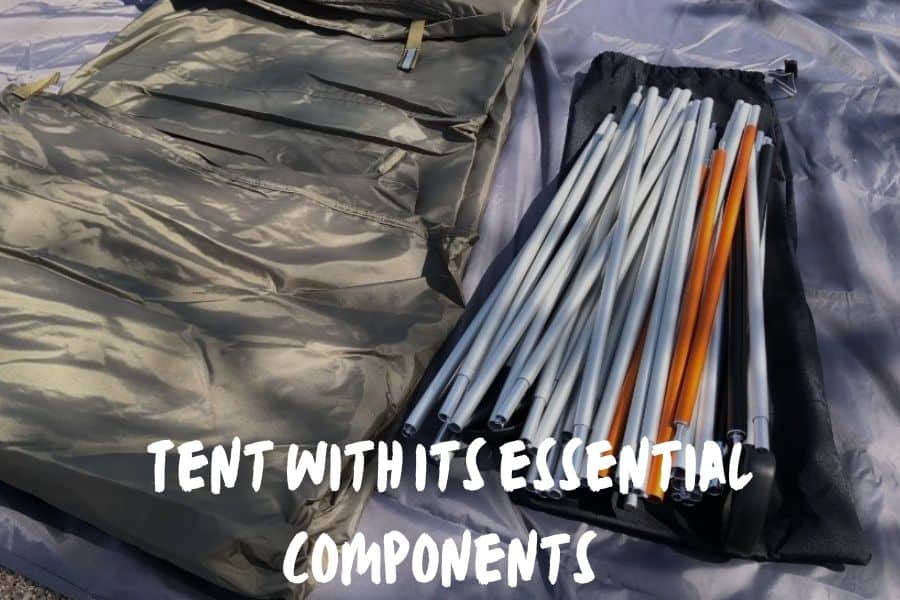
While it might seem too on the nose, it should be said that in order to learn how to use a tent stake, you need to have something to stake down!
Following this logic, for any campout you’ll need a tent body, rain fly, and poles to successfully set up a tent.
Once everything is ready to go, you can focus on staking it down!
Stakes
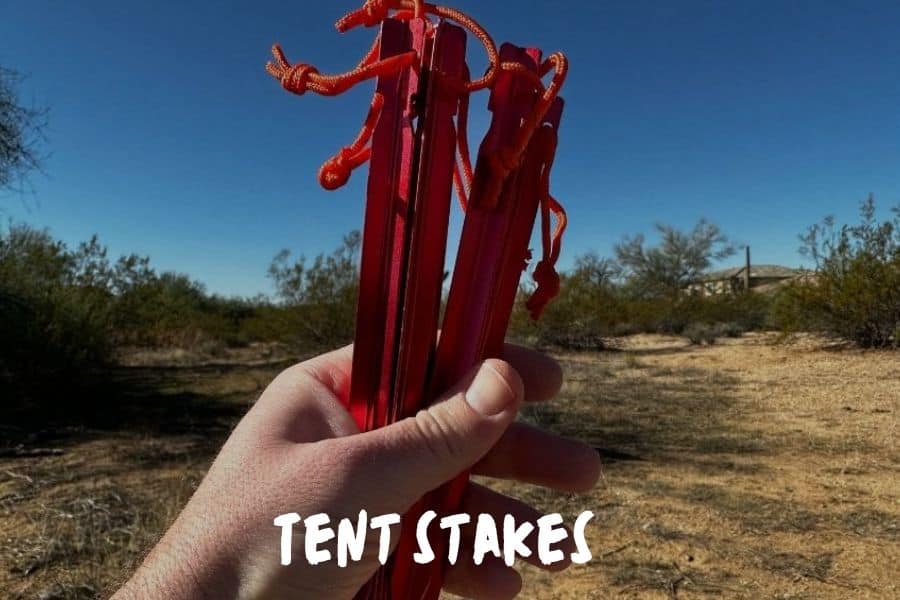
There are a wide variety of tent stakes on the market. Even though you will likely get a shepherd’s hook stake in your tent bag, you can always opt to buy a more advanced option to enhance your camping gear and ensure that your tent is secure.
From V-shaped to Sand/Snow Stakes, you can get a stake for almost any preference.
Want a stake that will keep you extra secure? V-shaped, Y-shaped, and Cyclone stakes will be best in adding an extra measure of stability to your tent.
Looking for a tent stake to use in sand or snow? V-shaped sand/snow stakes will be the best option for you.
The high percentage of surface area on this stake will ensure that it doesn’t slip and slide through the uneven ground.
Need an especially lightweight tent stake? Look for a tent stake made out of titanium of any design.
Also Read: Do Tents Come With Stakes? (Yes, But They Are Terrible)
Mallet Or Stake Hammer
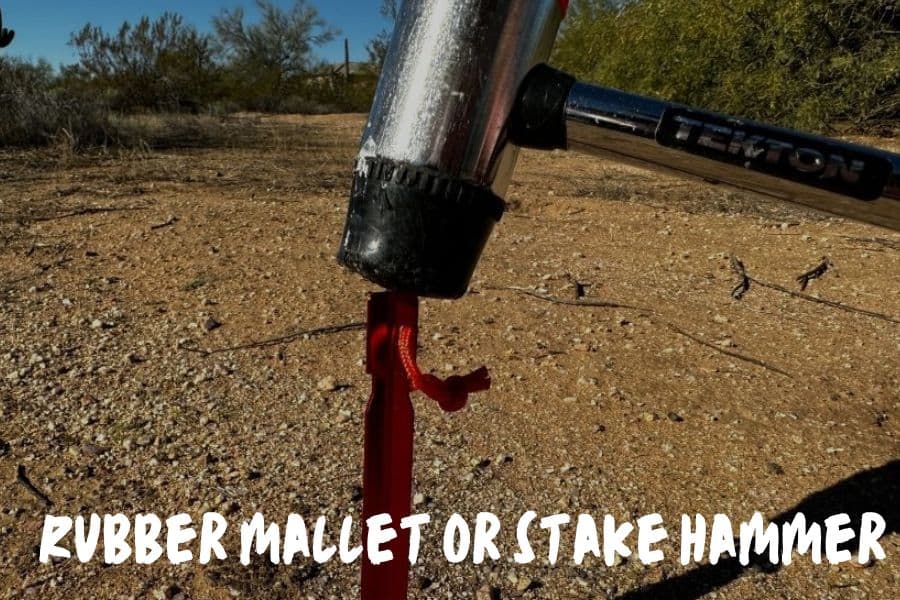
While a rubber mallet or stake hammer is not necessarily an essential piece of gear, they can be really helpful when you encounter especially hard terrain – and still need to make sure your tent is staked down!
This is because these tools help you exert more direct force on the stakes when driving them into the ground, meaning that your stakes will be far enough into the ground to gain traction and keep your tent secure.
If you don’t have the space for a rubber mallet or stake hammer in your pack, you can always use a lightweight rock or your boot to help drive the stake in.
However, these more “homemade” methods are less ideal because it’s more likely that you’ll bend the stake by applying force from the wrong angle.
Groundsheet Or Footprint
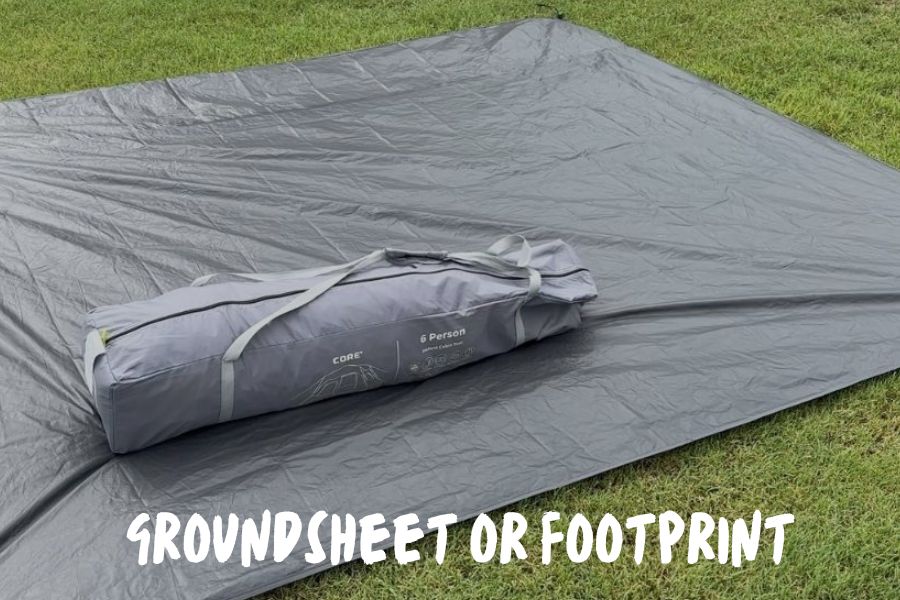
A groundsheet or tent footprint can be a great addition to your tent set up because it will shield the bottom of your tent from water and other debris.
Because of this, groundsheets and footprints are especially great for camping in bad weather conditions.
Staking down a groundsheet or tent footprint is pretty straightforward: All you need to do is line up the groundsheet with your tent body and stake it down on the four corners where you are also staking down the tent.
The holes on the corners of your tent structure and the groundsheet should line up, so you’ll be able to use the same stake for both the groundsheet and the larger tent structure.
Staking Your Tent
Choose The Right Location

You want to find the perfect spot with the best type of soil around. It’s much easier to stake a tent on hard soil than on sand – especially if you don’t have sand stakes.
What’s more, you don’t want any hard rocks or tree roots around. Not only can they make it harder to hammer down stakes, they can also make for a pretty uncomfortable surface to sleep on.
When picking the perfect spot to pitch your tent, take natural windbreaks into consideration, too. They’ll help keep your tent staked in windy weather.
Bushes, trees, large rocks – all of these can help protect you from the wind.
Tie Your Guylines
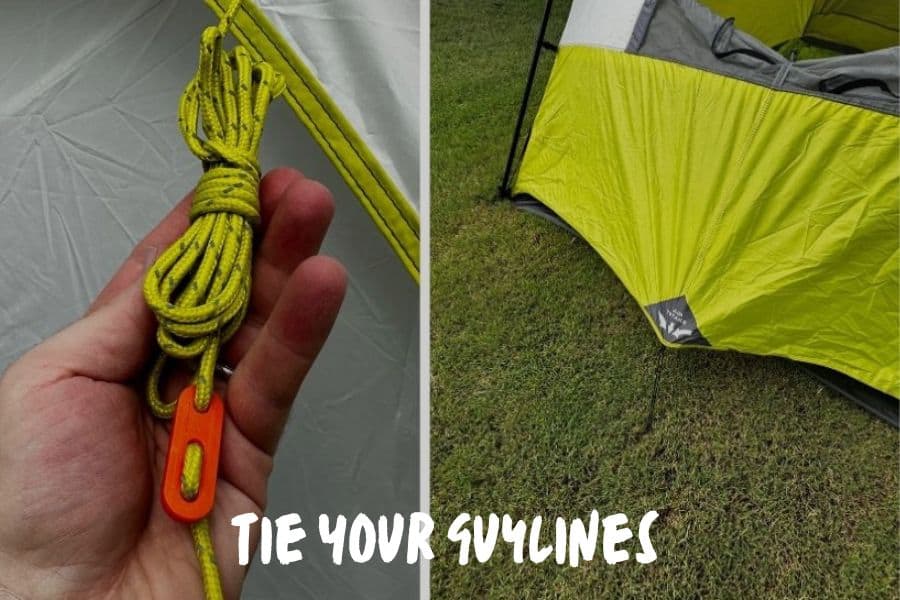
If you own an old canvas army tent, then you know that guylines are an essential piece of equipment. When tied to stakes, they’re what allows the tent to keep its shape.
In the case of a freestanding tent, guylines are generally optional. But if you’re looking for extra stability during windy conditions, they are your best friend.
And not only that! If you have a double-walled tent, guylines help with providing better airflow.
Those loops on your tent or rain fly? They’re called guyout points. One end of your guylines goes onto these loops, and the other around your stakes.
Usually, tents come with more guyout points than guylines, so you can choose where you want to tie them.
If it’s windy, you should tie the guylines to the upwind side of the tent, at the very least. But ideally, you want to stabilize each side equally. After all, the wind changes direction in an instant.
To attach a guyline to the loop, you need to make a secure knot – one that won’t untie under pressure.
For this, I’d recommend a taut line hitch. It’s easy to tie and untie, and it’s adjustable.
Hammer Your Stakes
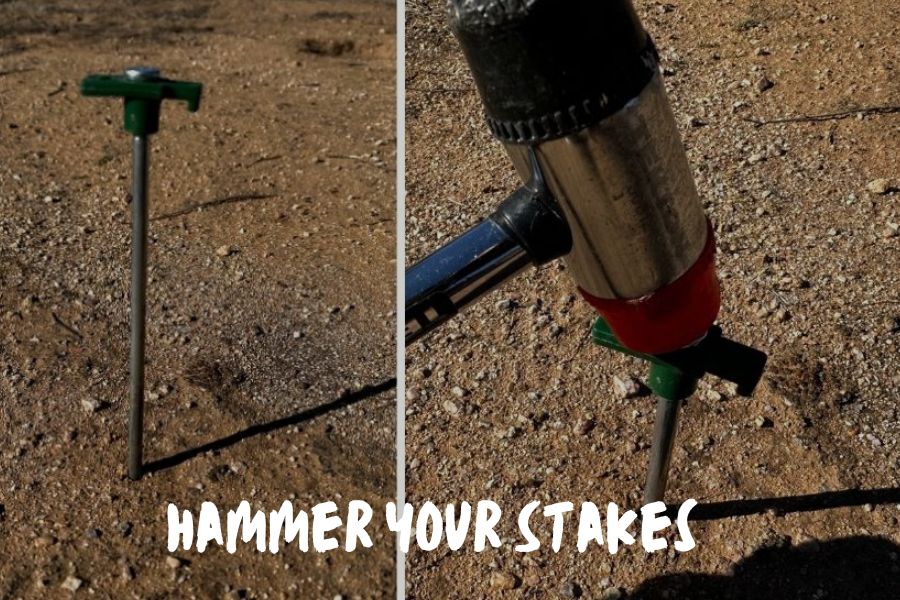
To make the best use of your tent stakes, hammer them all the way into the ground.
Leave just enough to be able to take them out at the end of your camping trip. When they’re all the way in, no strong wind can bend them and take them out of the soil.
When I say hammer the stakes down, I mean it literally. A rubber mallet should be on your camping gear list, but if it isn’t, opt for a flat rock or a thick piece of wood.
You might be tempted to use your foot to drive the stakes into the ground, but this is a recipe for disaster.
You’ll bend your stakes, or they’ll act like a shovel and dig out the soil, thus reducing their holding power.
Pro-tip! Many camping enthusiasts say to drive stakes in at an angle because it means greater grip. However, while this can be useful sometimes, this is generally incorrect.
When a tent stake gets hammered straight into the ground, it has a strong holding power regardless of the direction the wind blows.
It maximizes the soil wedge that provides resistance against the tent stake. To be honest, I was quite skeptical about this.
But after seeing it in action, I only stake my tent at 90° angles.
Reinforce Your Weak Points
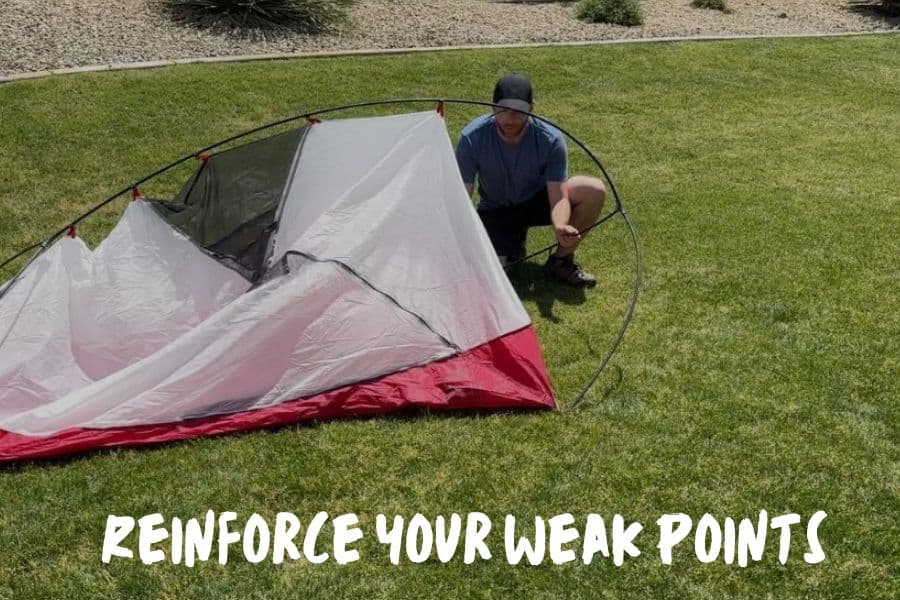
Depending on the soil, your stakes might not be as sturdy as you’d want.
If there are rocks nearby, these can prove to be quite helpful. If you place a heavy stone over your tent stake, there’s no wind strong enough to move it.
What’s more, you can replace tent stakes with stones altogether.
On really rocky ground, staking is not always an option. In that case, you can place heavy stones on all the corners of your tent.
Trust me, a 25-pound rock can hold your tent in place even better than your standard stakes would.
There’s another way you can use stones as an alternative to staking. For this, you’ll need both a smaller and a larger rock.
Take your guyline and tie a loop around a smaller rock. Position it on the ground in a way that keeps the guyline taut.
Then, take a large rock and place it on the guyline right before the point where it’s tied around the small rock. That will work as an anchor and keep it secure.
Staking For High Winds & Severe Weather
When you’re camping in high winds and severe weather, it can be even more important to make sure your tent is securely fastened to the ground.
You wouldn’t want any large gust to blow your gear (or you) away!
In this section, we’ll go over a few strategies you can use to make sure you stay safe and secure during bad weather.
Double Up On Stakes
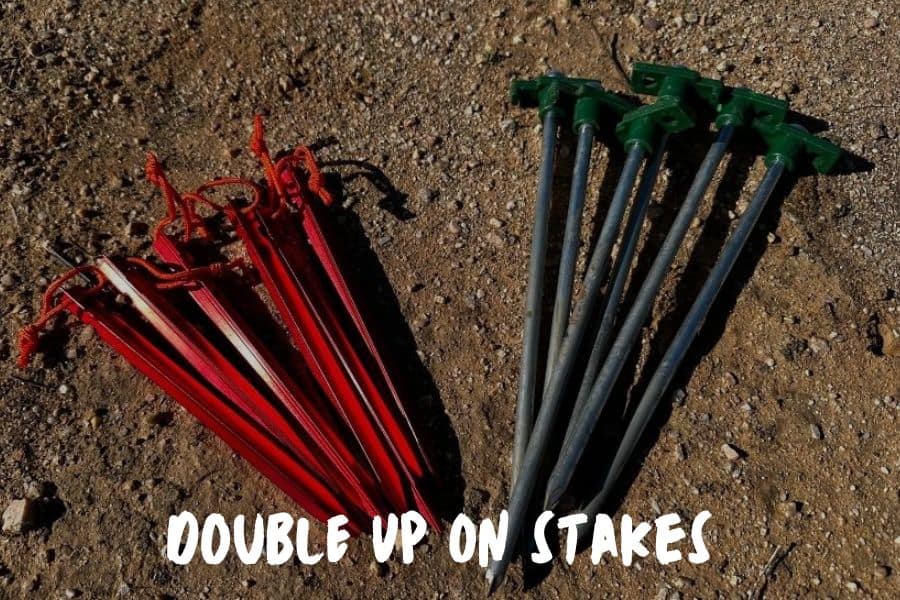
When in doubt, double down! Using double stakes around your tent can be a great way to prevent any potential stake failure that would leave your tent unstable or structurally compromised.
This technique is as easy as it seems. When you’re going around your tent to stake everything down, just use one more stake in each contact point!
Use Guylines For Additional Stability
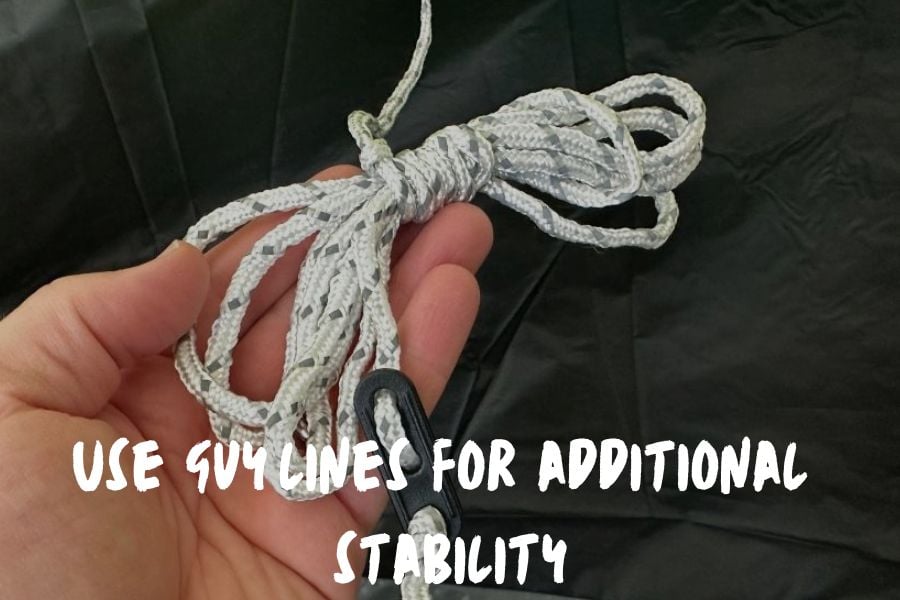
Guy lines are cords that extend from the exterior of your tent or rain fly to a stake in the ground. They are an extra part of the tent that ensures that the structure stays intact – and firmly on the ground.
You should already be using the guylines provided with your tent to secure the structure to the ground.
However, in harsh weather conditions, this becomes even more of a necessary step.
In high winds, adding extra guylines to your structure can help you take the extra step in staying locked and loaded on the ground.
Orient Your Tent Properly
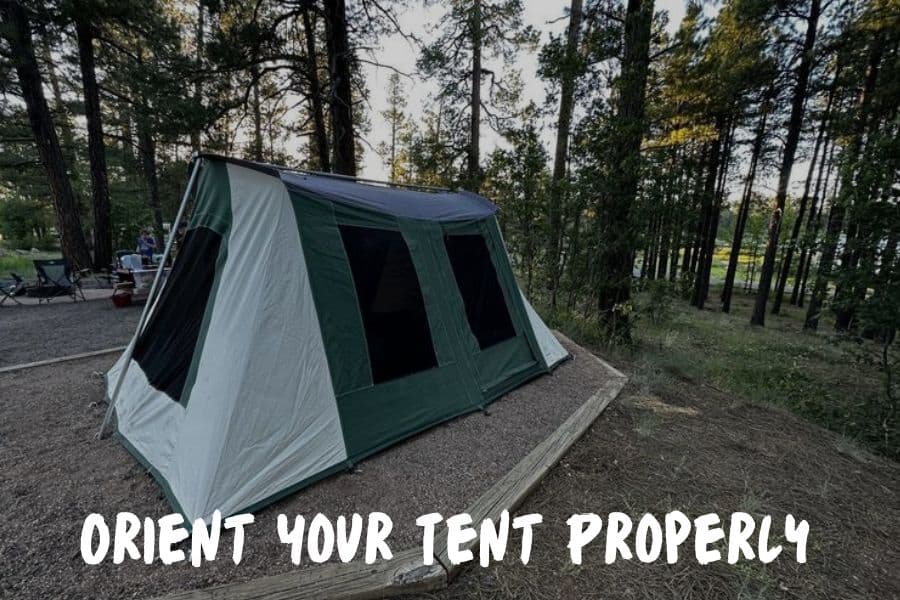
When you’re camping in a high wind environment, it’s best to set up your tent so that it has the least amount of resistance to the incoming winds.
Most backpacking tents are designed to remain structurally sound during high winds, and can even have a design that encourages wind to flow over and around them, rather than getting caught up in them.
When setting up your tent in high winds, it can be advantageous to orient your tent so that the narrowest parts are facing the wind, rather than the widest parts of the tent.
This way, you prevent your tent from becoming a sail and flying away.
Tent Stake Maintenance & Care
Tent stakes are an incredibly important part of your camping adventure. After all, they make sure that your tent stays where you put it!
Because of this, it’s incredibly important that you take good care of your tent stakes when you get home from your campout.
Clean & Dry After Use
When you get home from your campout, you should always clean and dry your tent stakes completely before storing them away.
This will prevent any rust from forming on the surface of the stakes and compromising the overall structure and stability of the stakes themselves.
If you’re camping in especially wet conditions or on a longer trek, I recommend wiping off your stakes with a dry cloth as you take them out of the ground in the morning, before you place them into the stake bag.
This will ensure that they aren’t exposed to repeated moisture, and that they won’t spread moisture throughout your pack.
Check For Bends Or Damages
When you’re back at home from your campout, it’s best to take a look at your stakes and make sure that you don’t see any irrevocably bent or damaged stakes.
Stakes can take a good amount of regular wear and tear, so a simple scratch isn’t a big deal.
However, if you’re seeing enough damage or bending that they are completely compromised, you may need to look for a replacement stake.
Store In A Cool & Dry Environment
The main cause of rust in tent stakes is moisture, so making sure that your stakes are completely dry before storing them away is a big step in preventing rust and other wear and tear.
You should also make sure that the space you store them in is consistently cool and dry.
Moisture from the surrounding air can also cause rust build up on the metal itself.
In addition, undue heat in the area has the potential to warp the metal and can compromise structural stability.
FAQs
How Deep Should I Drive The Stakes Into The Ground?
When you’ve used the stake properly, the majority of the stake will be inserted into the ground.
In general, I recommend having about ¾ of the stake inserted into the ground.
This positioning will give you enough stability from the ground, while also leaving room to attach the guylines or tent pieces.
How Do I Prevent Tent Stakes From Rusting?
The easiest way to prevent your stakes from getting rusty is to keep them dry when they’re in storage.
Rust is formed from residual moisture, so ensuring that both the stakes and the surrounding storage environment are dry will prevent any rust damage.
Additionally, if you’re camping in a particularly wet environment, it can be worth wiping them off before you place them in the stake bag.
My Tent Stakes Bent After A Single Use. What Did I Do Wrong?
If your tent stakes are coming out bent, it’s likely that you hammered them in at an angle when you were initially inserting them.
Don’t worry! Depending on the severity of the bend, it’s possible for you to use that stake again. You can even try to gently bend it back into a straight line.
This may also be the result of a stake that has been made with cheaper materials that are more prone to bending.
If you find that this is the case for you, it may be worth it to consider investing in higher quality stakes.
How Many Stakes Do I Typically Need For My Tent?
It depends on the size of your tent. Most two person tents require anywhere from 7–10 stakes.
The number increases from there by 2 or 3 depending on the size of the tent.
What Now?
A poorly staked tent can be a real downer on any camping trip. But doing it right is as easy as ABC.
Hopefully, our steps and tips will help you the next time you go to stake down your tent!
Next up: Should I Upgrade My Tent Stakes?


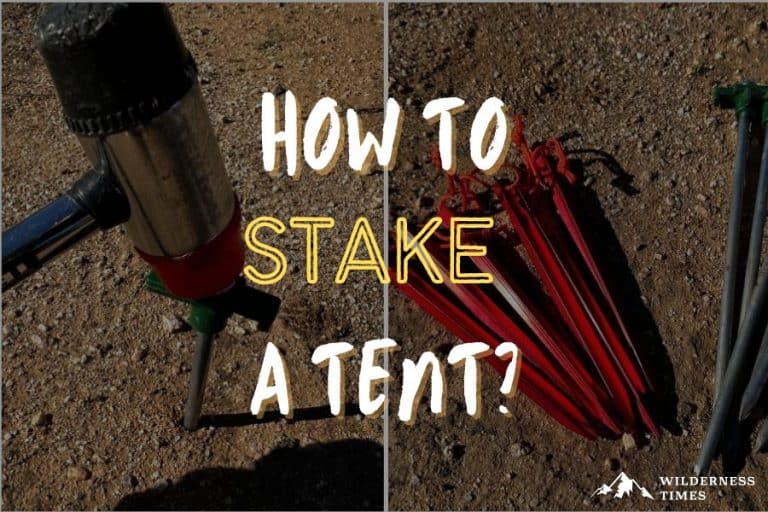
2 thoughts on “How To Stake A Tent (The RIGHT Way)”
Hello,
Follow up question.
Should ALL the stakes be straight, including the fly stakes and guylines, or just the tent stakes?
What about on a single walled tent?
Thanks
Hey Jane,
Yes, for maximum holding power, you’ll want to drive stakes straight and all the way into the ground.
If that isn’t possible, you can always reinforce weak stakes by placing a heavy rock on top of it.